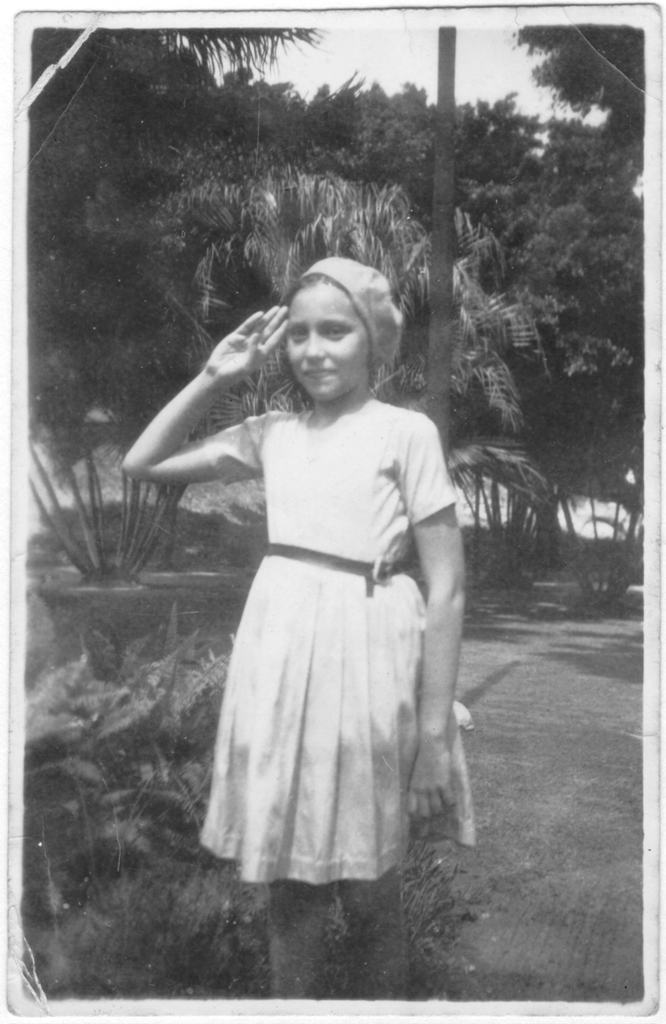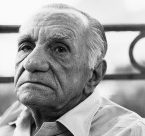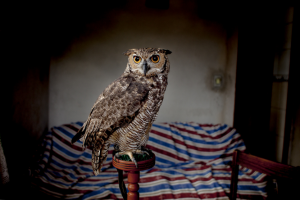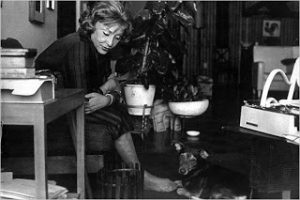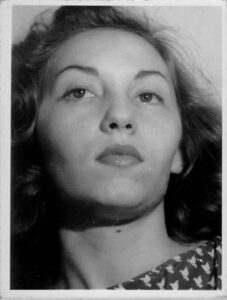Brites, Mell. Child and Origin. IMS Clarice Lispector, 2023. Disponível em: https://site.claricelispector.ims.com.br/en/2023/07/13/child-and-origin/. Acesso em: 08 January 2026.
Andrea Azulay was born in 1964, in the city of Rio de Janeiro. She graduated in Law from the Pontifical Catholic University and works as a realtor in the same city. Daughter of Jacob David Azulay, Clarice Lispector’s psychoanalyst, Andrea spent time with the writer in her childhood, when she was between ten and twelve years old. During those years, the girl stood out in her Portuguese language classes at school – proof of this is that she would earn second place in a literary contest – and her father seemed to nurture the dream that she would become a writer.
Benjamin Moser, Clarice Lispector’s biographer, recalls that Jacob David Azulay, after two decades leading the author’s daily therapy sessions that lasted from Monday to Friday, told her that he could no longer see her: “I was exhausted […] Clarice drained me more than all my other patients put together. The results were minimal. I was very tired of her and she of me. The effort that I made with her and that she made with me was very great for the little we got in return” (apud MOSER, 2009, p. 327). The patient-analyst transference relationship, then, turned into something close to a friendship, and thus the writer began to regularly visit the Azulays’ house, an agreement which they made so that they would not lose contact – and above all so that the author, who was going through a phase in which she found herself quite fragile, could still count on some support from the one who had been her great emotional foundation for so many years. Encouraged by Jacob, Clarice began to read the texts that Andrea wrote, and according to Lícia Manzo, author of Era uma vez eu: a não ficção na obra de Clarice Lispector (Once upon a Time There Was Me: Non-Fiction in the Work of Clarice Lispector), she was immediately enchanted by her writing, which was pure, free, innocent, and for that reason, in her view, extraordinary (MANZO, 1997, p. 164). Asked by the psychoanalyst whether his daughter could become a writer, Clarice would have answered: “She’s already a writer” (Idem, ibidem)1.
Andrea herself, however, presents another perspective to her own story and her relationship with writing:
My father was Clarice’s psychoanalyst for over twenty years. When I had contact with her, the relationship between them was already less orthodox, almost a kind of counseling. When I grew up, my father told me that she was an emotionally disturbed person who had suffered a lot. But she was brilliant, wasn’t she? Around the age of ten, with my school compositions, I was invited to do an interview program with other children from my school, who also stood out, on a culture channel. I don’t remember the program details. At the age of twelve, I won second place in a commentary contest about a book called L’oiseau et le barrage (The Bird and the Dam) […]. Several students from different schools competed. I wrote well… nothing absurdly fantastic as my father interpreted it. Proof of this is that I’m not the author of any books. I went to law school at PUC and really stood out… But I didn’t stand out, nor would I stand out in literature as my father had dreamed. What happened was that he showed my composition notebook to Clarice and asked if I could become a writer. She said I already was a writer. But let’s filter all this with the idea that Clarice idealized my father a lot, for the simple (or not so simple) fact that she had a strong emotional dependence on him. Well, I met with Clarice a few times, and I corresponded with her […]. She also compiled some of my essays into a small booklet of ten copies. […] But all of this ended up making me feel uncomfortable. A pressure that I’d surely have to shine professionally. And that’s not what happened. […]. I completely stopped writing around the age of twelve, when my father forced me to read a short story to the whole family. It was a lot of pressure. But I don’t blame my father: it was popular at the time. In the end, I didn’t improve. (AZULAY, statement)
In the view of the woman who became a realtor in the end, her talent was, above all, the projection of her father and also of Clarice, who saw in her texts their own desires and fantasies. If Jacob read in her well-chosen and articulate words the future of a brilliant author, Clarice perhaps reconnected through those same lines with her past as a debutant writer. But whether it was a precocious talent or not, the two began to meet and exchange correspondence, and in 1975, the author helped Andrea transform her poems and stories into a homemade book, as she herself recalls in her statement. Entitled Meus primeiros contos (My First Stories), the volume consists of a collection of thirteen texts by Azulay written in her handwriting on lined sheets, in addition to a presentation by Clarice, also handwritten, and illustrations by Sérgio Rubens Matta, a visual artist who met the author in 1974 and in the same year illustrated her children’s book Laura’s Intimate Life. In one of the stories can be read:
Dreams
Dreams are mountains that thoughts must climb.
There are no dreams without thoughts, there is no spring without flowers.
Dreams are the seeds of flowers.
Seeds are what make love bloom.
Dreams are the slippage of our moments.
There are no dreams without thoughts.
There is no spring without flowers.
That is why I offer this dream, mom, with all my love.
(AZULAY, unpublished material)2
In the collection, there are other texts like this one, written in verse, sometimes rhyming, with a marked rhythm, and there are also prose narratives. The themes revolve around the beauty of nature (birds, the sea, flowers), the power of love, and love for mothers. Apparently of a diffuse romantic inspiration, both for their motifs and for the form that they seek to emulate, her stories are presented as a salute to life and to the natural elements that are present in the everyday. It is curious that the girl wrote a text called “A rosa branca” (The White Rose), which is also the title of a narrative by Clarice:
In a day a seed broke open, and from it, a white rose was born.
Be it as it may,
It fights hatred and pain.
Ha, flower! You’re my symbol of love!
It’s a flower that has brought bonanza,
The flower that brings hope.
This one, it’s a white rose
A white and frank rose
The flower that brings hope,
A child rose,
A white rose,
THE WHITE ROSE.
(AZULAY, unpublished material)3
As can be observed, for a girl of ten or eleven years old, whose literary experience is still incipient, writing means expressing her “noble” feelings in the face of the enchantment of what is alive. Clarice’s “Rosa branca” (White Rose), in turn, is described by a narrator who, faced with her encounter with the flower, opposes its sublime existence to her precarious human nature:
Petal up high: what an extreme surface. Cathedral of glass, surface of the surface, unreachable by voice. Through your stem two voices join a third and a fifth and a ninth — wise children open mouths in the morning and chant spirit, spirit, surface, spirit, untouchable surface of a rose.
I reach out my left hand which is the weaker, dark hand that I quickly withdraw smiling demurely. I cannot touch you. My crude thinking wants to sing your new understanding of ice and glory. (LISPECTOR, 2022b, p. ??)
Although notably distant in form and content, considering even the sensual appeal that Clarice’s rose carries, there is something that seems to unite both universes. Andrea sings the force of nature as much as Clarice, and the two authors/narrators, given the particularities of a child in her first exercises with language and of a mature woman whose writing career is already consolidated, position themselves in relation to natural beings as if they were before the sublime: “I rise until I reach my own appearance. I pale in that frightened and fragile region, I nearly reach your divine surface…” (Idem, ibidem), says Clarice’s text. In this sense, the author who was always seeking approximation to and revelation of the sacred, and who searched for it in the formless mass of the cockroach, in the perfection of the egg, in inanimate things, in animals that “just are” and in the wild heart of the human buried by rationality, she possibly saw some echoes in Andrea’s text. In another story entitled “Obrigado Deus” (Thank You God), the girl says: “Thank you for giving us the chance to search for the love that exists. Finally, for our discovering the most beautiful thing you have done. Nature, birth, finally the world” (AZULAY, unpublished material).4 Azulay, with her youth, spontaneity, and detachment for writing, seemed herself to signify a contact with that primordial, almost divine realm that Clarice incessantly sought.
Through letters, she gave the girl advice about her writing, about the profession of a writer, and of course, about life in general:
To the beautiful princess Andréa de Azulay,
You need to know that you already are a writer. But don’t pay any attention to that, pretend you’re not. What I wish for you is to be known and admired only by a delicate but large group of people spread across the world. I hope that you never attain cruel popularity because that is bad and invades the sacred intimacy of our hearts. Write about eggs because that works. It also works to write about stars. And about the warmth that animals give us. Surround yourself with divine and human protection, always have a father and mother—write whatever you like without worrying about anyone else. Do you understand? (apud MOSER, 2009, p. 330)5
In another one, she says:
Andrea de Azulay, who is my spiritual daughter,
[…] Suggestions for writing: you don’t need anything, you already know almost everything. But I’ll give you some ideas: – Don’t forget about punctuation. Punctuation is the breath of the sentence. A comma can take your breath. It’s better not to use too many commas. Use question marks and exclamation marks whenever you need them: they’re valid. Be careful with ellipses: only use them in rare cases. Like after a sigh. As for semicolons, they’re bones stuck in the sentence’s throat. A friend of mine that I spoke to about punctuation added that a semicolon is a hiccup in a sentence. The dash is very good for us to rely on. Now forget everything I said. […]
When you succeed, be content but not too content. One always needs to keep a simple humility in life as in literature. (apud MANZO, 1997, p. 169)6
It is curious to see that the affectionate way in which Clarice communicated with Andrea recalls the narrators found in her children’s books. In The Woman Who Killed the Fish, from 1968, we read: “That woman who killed the fish unfortunately is me. But I promise you I didn’t do it on purpose. […] I give you my word that I’m someone you can trust and my heart is kind: around me I never let a child or an animal suffer” (LISPECTOR, 2022c, p. ??); “If you like to write or draw or dance or sing, do it because it’s great: as long as we’re playing around like that, we don’t feel lonely, and our hearts warm up” (Idem, p. ??).
In this book, her second that she published for children, the first-person narrator presents herself as a mother and writer named Clarice who seeks to convince readers that she killed her children’s two fish by accident, because she was overworked. In the midst of her accounts about the animals with which she had lived throughout her life, she explores themes such as loss, nostalgia, revenge, and in a tone of dialogue, shares her reflections with her child. From her experienced position, the narrator advises the readers, but – and this is possibly the most significant feature of her work for children – she considers them as capable of being an interlocutor as any adult. Marisa Lajolo and Regina Zilberman, in Literatura infantil brasileira: história e histórias (Brazilian Children’s Literature: History and Stories) affirm that between the 1960s and 1970s, texts for children were finally breaking free from the excessive moralism and pedagogism that until then had dominated children’s literature in the country, and it is precisely in this period that Clarice Lispector, through her narrators, engages in a horizontal relationship with readers, in which she does not hide her own limitations (LAJOLO; ZILBERMAN, 1985). Without traces of condescension, then, The Woman Who Killed the Fish deals with themes considered taboo, while at the same time embracing the difficulties of its interlocutors.
In the same book we read: “But if I swear to God that everything I told you in this book is true, would you believe me? Then I swear to God that everything I’ve told you is completely true and really happened. I respect boys and girls and that’s why I don’t ever trick them” (LISPECTOR, 2022c, p. ??). One can deduce, then, not only that children and adults are considered equally capable, but also that the former possess their own qualities that are shown to be valuable to the narrator, such as their ability to be truthful. Another characteristic that is highlighted is the vocation of children for storytelling: “Gee […], I just smelled an idea so good that it seems like something a kid would have thought up!” (LISPECTOR, 2022c, p. ??). Not by chance, she says to Andrea: “You need to know you’re already a writer. But don’t pay attention, pretend you’re not,” or “you don’t need anything, you already know almost everything.”
In The Mystery of the Thinking Rabbit, a book written at the request of Paulo, the writer’s son, and published in 1964, the plot unfolds around a rabbit that is apparently the same as any other, but that discovers a way to escape its cage and thus starts to come and go from its home whenever it feels like it. The narrator, who forges the same colloquial tone and environment of dialogue as in The Woman Who Killed the Fish, leaves the enigma open here and hands it over to the readers – only they seem to be able to solve it, with the help of their imagination. In the text “A brincadeira é” (Games Are), by Azulay, we find the same appeal to the ludic, when the girl demonstrates an awareness of the power of invention in her life as a girl: “Games are my child time, which have only brought me hope. They are my time for joy, love, and fantazy [sic]” (AZULAY, unpublished material).7
The storytelling exercise comes to acquire nonsensical tones in Laura’s Intimate Life, and in the posthumous work Almost True it assumes the general framework of the narrative. In the Laura’s story, which was published in 1974 and whose epigraph is curiously a poem by Andrea, the protagonist is a hen and lives like any other: she lives in the chicken coop, is married to the rooster Luís, and spends her days without major incidents; she eats, lays eggs, pecks. The pace of the narrative is, like Laura’s life, quite peaceful, without the presence of major events in the plot. The fantastic moment – which has the most action in the story – takes place when, during the night, an extraterrestrial appears in the chicken coop to talk to Laura and assures her that she will not be eaten, despite her already getting old and feeling that the owner of the coop has his sight set on her. They have a dialogue, then the extraterrestrial goes away and the story ends with the sentence: “Laura’s nice and alive.”
Eggs and chickens consist of one of the author’s great obsessions, and both appear from different perspectives throughout her work. But in most of her texts directed at an adult audience, the chickens, even though they arouse Clarice’s fascination, meet their fate of the “Sunday chicken.” It is interesting to note, in this sense, that only in her children’s work does another way out become possible, and it is in the realm of fantasy, the space of childhood par excellence, that Laura ends up being saved by an extraterrestrial. Almost True, from 1978, is dictated from the start by a nonsensical and carnivalesque logic, in which references coexist, ranging from the Bible to Monteiro Lobato, from Homer to Aesop’s fables. This allegorical story is narrated by Ulisses, who introduces himself to readers as Clarice’s dog and whose barking will be translated into words by its owner. Of all her children’s books, this is the only one that contains a linear plot and an established conflict: also in a chicken coop, an envious fig tree that lives there decides to manipulate the chickens to profit from their work. So, with the help of a witch, it finds a way to light itself up at night, making the chickens think that it is daytime and therefore that they must lay eggs. They come to produce eggs incessantly, until they discover that they are the victims of an evil plan, they rebel, they face the evil fig tree, and peace returns to the environment.
More or less fantastic in their plots, these children’s stories reveal narrators who, stripped almost completely of their fictional character, are very similar to the author: they are mothers, writers, they go by the initials “C.L.,” or even say their name is Clarice. In addition, through the narrative structure in the form of a dialogue, they approach the reader and allow themselves to exercise the imagination. Thus, if there is a horizontal posture in these narrators in which respect for the particularities of childhood is presupposed, this same movement also shows the desire to become a little more like a child. Olga Borelli says, in a statement to Lícia Manzo: “Clarice was delighted with Andrea’s innocence and intelligence. I think that contact with children and animals in general invigorated and touched her at the same time” (MANZO, 1997, p. 168-9).8
The approximation with childhood, in her work and outside of it, became more and more constant in the last years of the writer’s life, precisely when she met Andrea, as she herself grew older and saw herself with limitations, both physical and in relation to that which she sought through the exercise of writing. The utopian encounter with the “inside,” pursued since her first book, seemed to have reached a paradox, based on the perception that words would always be at the service of reason and thus would never lead her to her objective. It is during this period that Clarice says: “As for me — all that’s left for me is to bark at God” (LISPECTOR, 2022a, p. ??) – and it is also at this same moment that Ulisses arrives, the iconic dog who narrates the last children’s book that she wrote. “Ulisses would become a faithful companion for Clarice at all times, appearing in practically all of her books from then on. Andrea would also be an important reference and Clarice would even use one of her poems as an epigraph in one of her future books,” says Lícia Manzo (MANZO, 1997, p. 169).9
It does not seem to be a coincidence, then, that it was in the last decade of her life when the author wrote most of her books for children, as well as the short stories for an adult audience in which she recalls her childhood in Recife. Surrounded by the characters in her memoir texts, her children, Ulisses, chickens, readers of her children’s work, and Andrea Azulay, Clarice perhaps felt that she was at least groping for that unreachable realm in which “just being” prevailed over reason. And Andrea’s brilliance, in this way, was shown precisely in her proximity to a universe that was less dependent on rational logic and fonder of creative freedom, less attached to social rules and more connected to primordial needs – just like the children interlocutors in her children’s stories. For the experienced writer, that girl who was just beginning her career meant a radical encounter with otherness. Contrary to what Andrea thinks today, when she says that Clarice’s sympathy for her was nothing more than “a great idealization” of the writer by her father, that child, spontaneous and talented with words, was a precious possibility for Clarice to start over, return to her origins, and recover the meaning of her craft: storytelling with no strings attached. After all, she herself went so far as to say that “Before I could read and write I already made up stories” (apud MOSER, 2009, p. 104). And to whom, if not to herself, would she be saying that “I hope that you never attain cruel popularity because that is bad and invades the sacred intimacy of our hearts,” or that “One always needs to keep a simple humility in life as in literature?” By affirming, in a chronicle published in the Jornal do Brasil, that “there’s nothing I can do about it: it seems there is a childish side of me that will never grow up” (LISPECTOR, 2022d, p. ??), the author reinforces her commitment to the sacred origin, even if it is unattainable, and with her own story. And the relationship with Andrea Azulay meant nothing else but a renewal of her vows, perhaps for the last time, to writing as a way of life.
Notes
1 The original quote in Portuguese reads: “Ela já é uma escritora.”
2 The original quote in Portuguese reads: “O sonho/ O sonho é uma montanha que o pensamento há de escalar./ Não há sonho sem pensamento, não há primavera sem flor./ O sonho é a semente da flor./ A semente que faz brotar o amor./ Sonho é o deslizamento do nosso momento./ Não há sonho sem pensamento./ Não há primavera sem flor./ Por isto ofereço esse sonho, mãe, com todo o amor.”
3 The original poem in Portuguese reads: “Num dia uma semente se rompeu, e dela, uma rosa branca nasceu./ Sela ela como for,/ Combate o ódio e a dor./ Ha, flor! Você é meu símbolo do amor!/ Ela é uma flor que trouxe a bonança,/ A flor que traz esperança./ Esta, é uma rosa branca/ Uma rosa branca e franca/ A flor que traz esperança,/ Uma rosa criança,/ Uma rosa branca,/ A ROSA BRANCA”
4 The original quote in Portuguese reads: “Obrigado por ter nos dado a chance de procurarmos o amor que existe. Enfim por termos descoberto a coisa mais linda que fizestes. A natureza, o nascimento, enfim o mundo.”
5 The original quote in Portuguese reads: “À bela princesa Andrea de Azulay, […] Você precisa saber que já é uma escritora. Mas nem ligue, faça de conta que nem é. Eu lhe desejo que você seja conhecida e admirada só por um grupo delicado embora grande de pessoas espalhadas pelo mundo. Desejo-lhe que nunca atinja a cruel popularidade porque esta é ruim e invade a intimidade sagrada do coração da gente. Escreva sobre ovo que dá certo. Dá certo também escrever sobre estrela. E sobre a quentura que os bichos dão a gente. Cerque-se da proteção divina e humana, tenha sempre pai e mãe – escreva o que quiser sem ligar para ninguém. Você me entendeu?”
6 The original quote in Portuguese reads: “Sugestões para escrever: você não precisa de nada, já sabe quase tudo. Mas vou lhe dar umas ideias: – Não descuide da pontuação. Pontuação é a respiração da frase. Uma vírgula pode cortar o fôlego. É melhor não abusar de vírgulas. O ponto de interrogação e o de exclamação use-os quando precisar: são válidos. Cuidado com reticências: só as empregue em caso raro. Como depois de um suspiro. Quanto ao ponto e vírgula, ele é um osso atravessado na garganta da frase. Uma amiga minha, com quem falei a respeito da pontuação, acrescentou que ponto e vírgula é o soluço da frase. O travessão é muito bom para a gente se apoiar nele. Agora esqueça tudo que eu disse. […] Quando você fizer sucesso fique contentinha mas não contentona. É preciso ter sempre uma simples humildade, tanto na vida quanto na literatura.”
7 The original quote in Portuguese reads: “A brincadeira é o meu tempo de criança, que só me trouxe a esperança. É o meu tempo de alegria de amor e fantazia [sic].”
8 The original quote in Portuguese reads: “Clarice ficava encantada com a inocência e inteligência de Andrea. Penso que o contato com crianças e animais de um modo geral a revigorava e enternecia simultaneamente.”
9 The original quote in Portuguese reads: “Ulisses se tornaria para Clarice um fiel companheiro de todas as horas, aparecendo em praticamente todos os seus livros dali por diante. Andrea seria também uma referência importante e Clarice chegaria mesmo a usar um de seus poemas como epígrafe num de seus futuros livros.”
References
LAJOLO, Marisa; ZILBERMAN, Regina. Literatura infantil brasileira: história e histórias. São Paulo: Ática, 1985.
LISPECTOR, Clarice. A Breath of Life. London: Penguin Books, 2022a.
______. The Complete Stories. Translated by Katrina Dodson. London: Penguin Books, 2022b.
______. The Woman Who Killed the Fish. Translated by Benjamin Moser. New York: New Directions, 2022c.
______. Too Much of Life: The Complete Crônicas. Translated by Margaret Jull Costa and Robin Patterson. New York: New Directions. 2022d.
MANZO, Lícia. Era uma vez eu: a não ficção na obra de Clarice Lispector. Curitiba: Secretaria do Estado da Cultura, 1997.MOSER, Benjamin. Why This World: A Biography of Clarice Lispector. Oxford: Oxford University Press, 2009.

